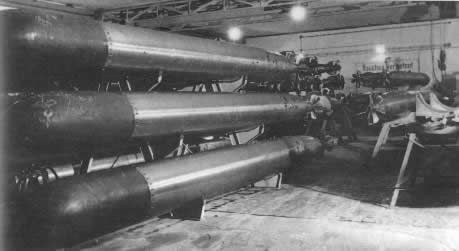By the end of World War I, the submarine torpedo, the first really successful model of which had been produced by the Anglo-Italian Whitehead in 1868, had been developed to the point where it was a reliable, practical weapon. During that war it had been used to sink thousands of ships (German submarines alone accounted for 5556), and we can hazard a guess that the individual success rate (expressed as hits per torpedo) probably made it one of the most effective offensive weapons of the whole conflict. However, it was a relatively simple, unsophisticated weapon, and that, combined with its effectiveness, surely meant that it could be improved. There was certainly the possibility of giving it much greater endurance and straight-line performance, but increasing the range always resulted in a lowering of the strike rate, since the torpedoes had no self-directive capability. There is reason to believe that scientists in Germany had actually perfected a passive acoustic homing device to steer a torpedo towards a submarine sound source by 1936, and that the new weapon had been kept back from production to preserve its secrecy.
FOXING THE ‘FOXER’
The relatively simple first-generation devices, which were restricted to fairly low speeds, proved effective against slow-moving targets such as merchant ships, but less so against warships, which often simply outpaced them. Towed noise-makers (known as ‘Foxers’; originally no more than two lengths of iron pipe, chained loosely together so that they constantly crashed into each other) could also dupe these devices, and it was September 1943 before German scientists perfected a means of outwitting them.
When a torpedo fitted with the second-generation T5 or ‘Zaunkönig’ (‘Wren’) passive acoustic seeker detected a sound source in a small arc ahead of it, a subsidiary circuit operated a simple solenoid switch to actuate the small rudder vane. This caused the torpedo to turn sharply to starboard and run in a circular path for a predetermined period (long enough, in fact, for it to describe a semi-circle) before turning sharply to starboard once more and setting off on its original track again. In this way, the torpedo skirted the noisemaker and homed in on the propeller noise of the ship towing it instead. Then, on encountering the noise of the ship dead ahead, the torpedo turned to perform the circling manoeuvre once more. The diameter of the semi-circular track the torpedo described being less than the length of the ship plus the distance the latter covered in the intervening period, it would strike the equipped Mark 27 torpedo in 1944, and in the last years of the war, 106 were fired in combat, scoring 33 hits (31 per cent).
Another approach was to fit a form of automatic pilot, which caused the torpedo to make a series of pre-programmed turns after it had run a preset distance, in the hope that a torpedo fired in the general direction of a convoy would turn and hit a ship purely by chance. Neither the success rate of the Federapparat-Torpedo, nor that of its more sophisticated successor, the Lagenunabhangiger-Torpedo (which could be fired from depths of up to 50m; 164ft), seems to have been recorded. Later U-boats had their six forward-facing torpedo tubes organised into an array which covered 10 degrees of arc; firing all six in a salvo gave a much-improved chance of hitting the target. It is obvious that the same guidance system which was applied to the glider bombs and the guided missiles could also have been applied to torpedoes, even though keeping a precise track of the missile’s course would naturally have been more difficult. It is inconceivable that an experimental programme, at least, was not initiated. Certainly, one of the Kriegsmarine’s original submarine warfare instructors, Werner Fürbringer, suggested it.
A viable alternative to the torpedo was to lay mines in the path of the oncoming enemy (particularly if this was a slow-moving convoy), and a variety of submarine- launched mines were developed. The Torpedo- Ankertaumine (TMA) had a 215kg (4751b) explosive charge, and was attached to an anchor which allowed it to float at a predetermined height, while the Torpedo-Grundminen lay on the seabed in shallower water. They came in two sizes: the 500kg (1100lb) TMB and the 1000kg (2200lb) TMC. All three mines were dimensioned to allow them to be deployed target from the beam. It has been estimated that 700 T5s were fired in anger, and that 77 (11 per cent) scored hits. The US Navy introduced the similarly through a standard 533mm (21in) torpedo tube and could be fitted with a variety of remotely actuated detonators, magnetic or acoustic.
